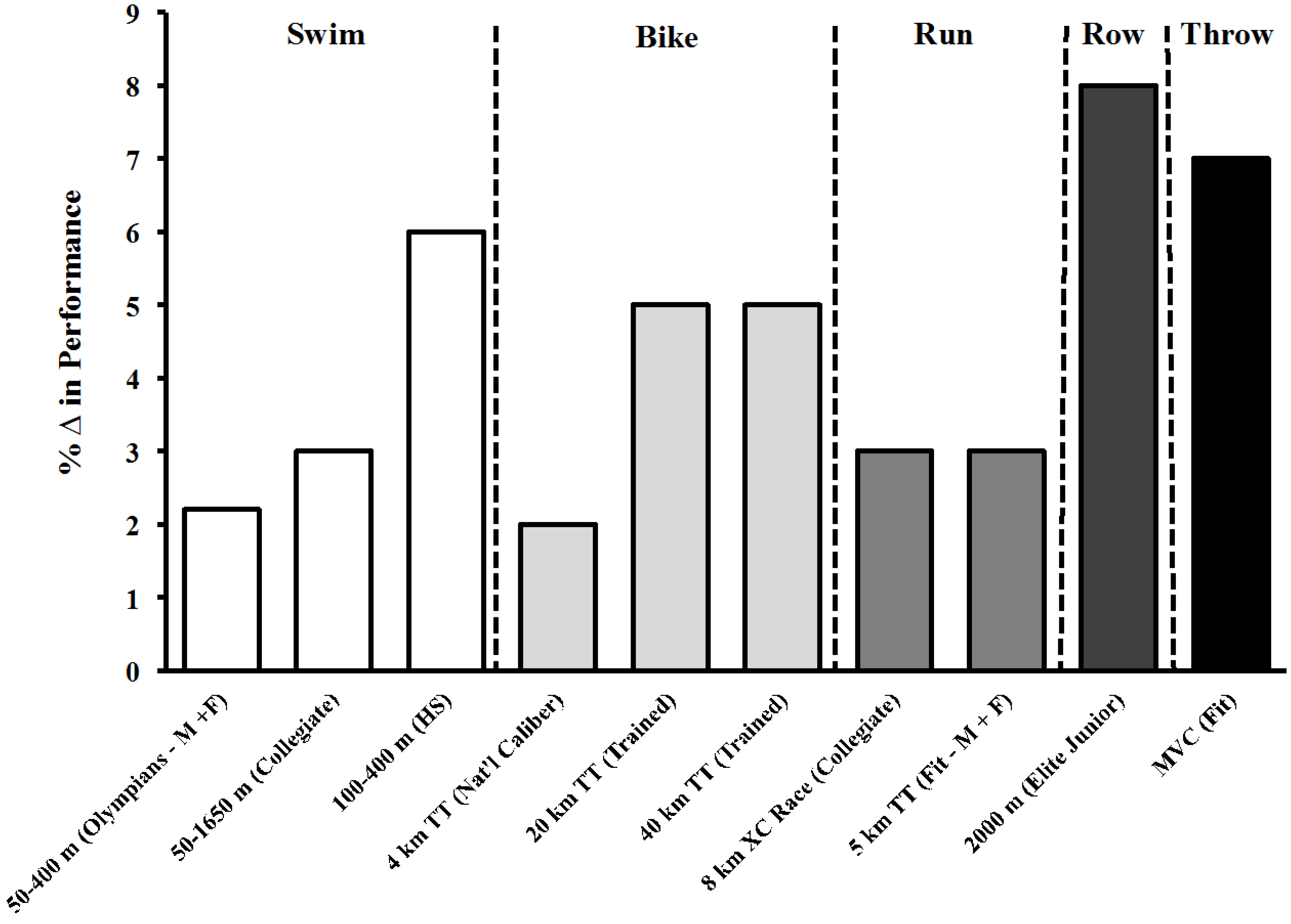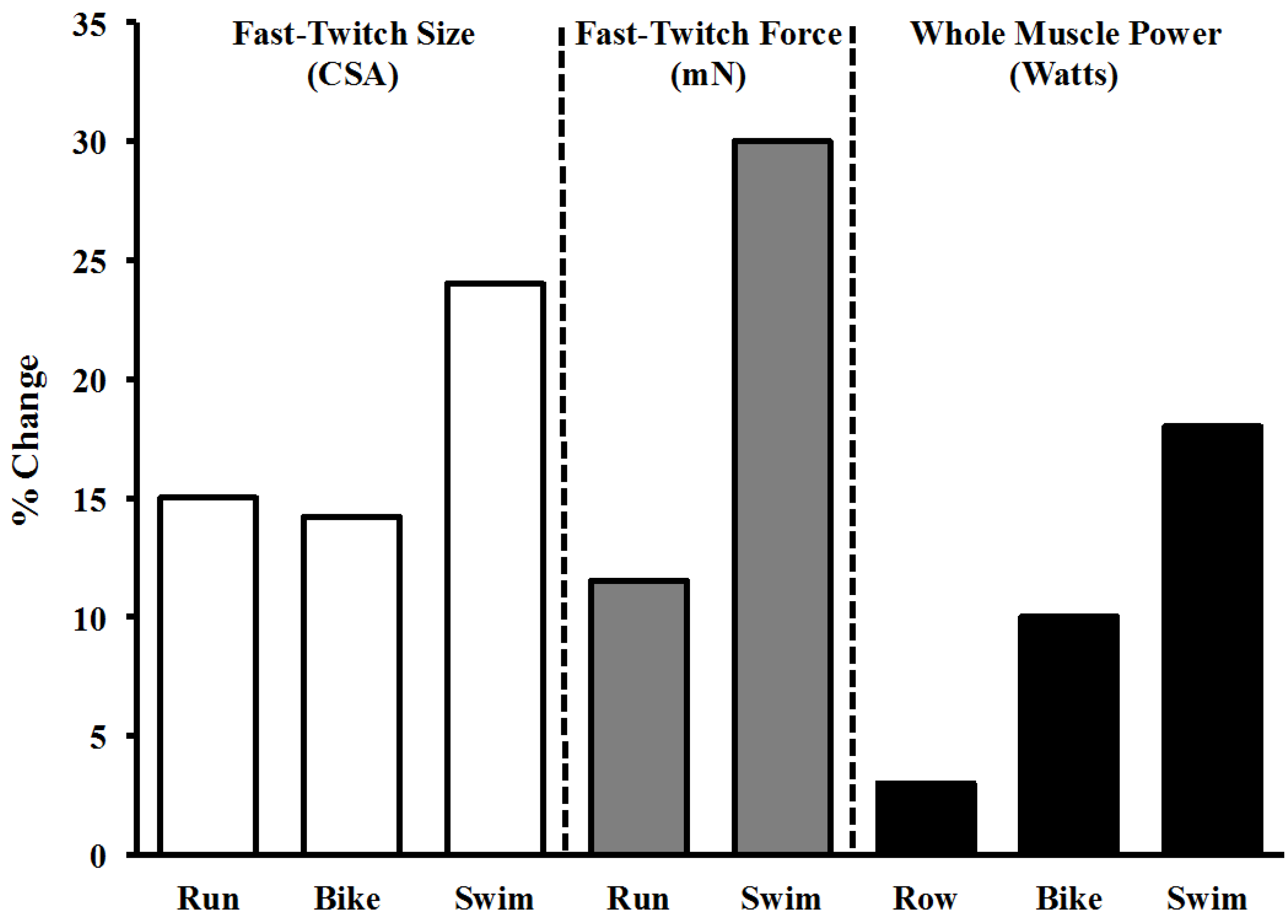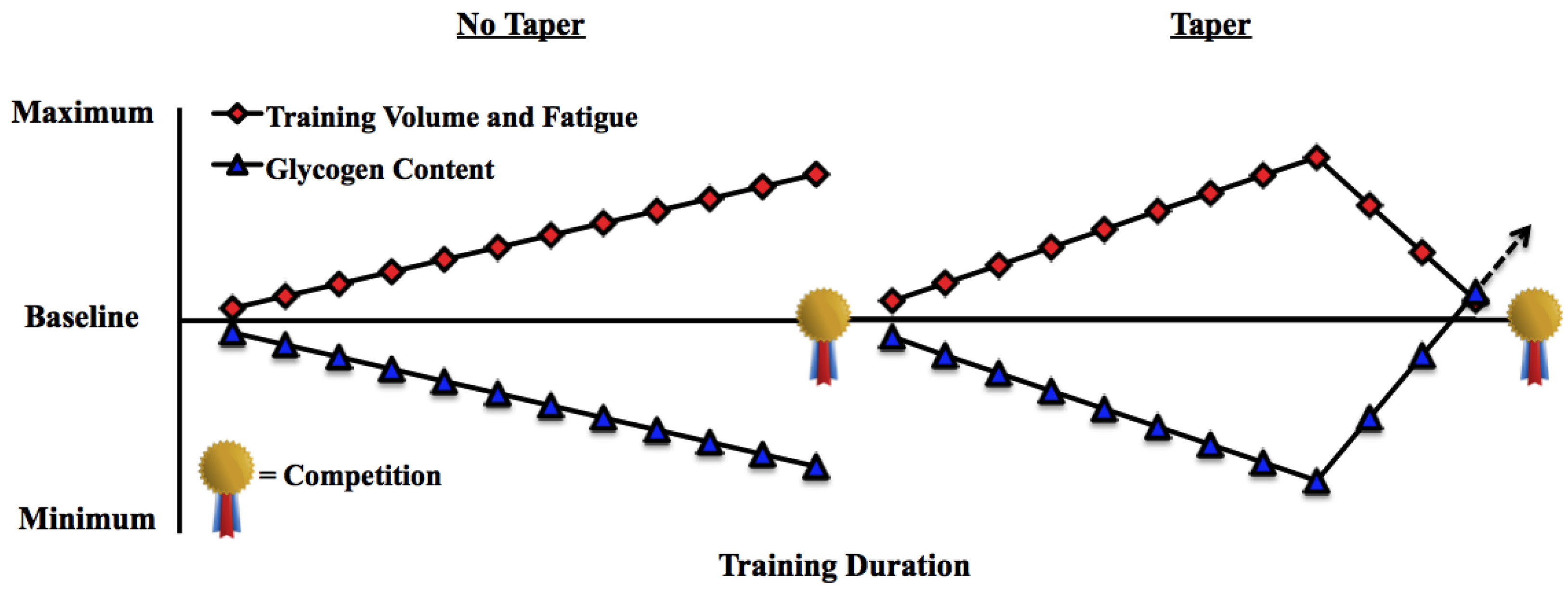Less Is More: The Physiological Basis for Tapering in Endurance, Strength, and Power Athletes
Abstract
:1. Introduction
2. How to Taper
3. Magnitude of Performance Benefits with Taper

4. Fitness Is Not Lost with Taper
5. Taper and Muscle Energy Usage
6. Taper Improves Muscle Power in Endurance Athletes

7. How Tapering Improves Performance in Strength and Power Athletes
8. Summary and Perspectives
9. Practical Applications
Author Contributions
Conflicts of Interest
References
- Spivey, J. The Ancient Olympics; Oxford University Press: Oxford, UK, 2004. [Google Scholar]
- Bompa, T. Theory and Methodology of Training: The Key to Athletic Performance; Kendall/Hunt Publishing Company: Dubuque, IA, USA, 1983. [Google Scholar]
- Matveev, L.P. Periodization of Sport Training; Fizkultura I Sport: Moskow, Russia, 1965. [Google Scholar]
- Costill, D.; King, D.; Thomas, R.; Hagreaves, M. Effects of reduced training on muscular power in swimmers. Phys. Sport Med. 1985, 13, 94–101. [Google Scholar]
- Luden, N.; Hayes, E.; Galpin, A.; Minchev, K.; Jemiolo, B.; Raue, U.; Trappe, T.A.; Harber, M.P.; Bowers, T.; Trappe, S. Myocellular basis for tapering in competitive distance runners. J. Appl. Physiol. 2010, 108, 1501–1509. [Google Scholar] [CrossRef] [PubMed]
- Murach, K.; Raue, U.; Wilkerson, B.; Minchev, K.; Jemiolo, B.; Bagley, J.; Luden, N.; Trappe, S. Single muscle fiber gene expression with run taper. PLoS ONE 2014, 9. [Google Scholar] [CrossRef] [PubMed]
- Berger, B.; Motl, R.; Butki, B.; Martin, D.; Wilkinson, J. Mood and cycling performance in response to three weeks of high-intensity, short-duration overtraining, and a two-week taper. Sport Psychol. 1999, 13, 444–457. [Google Scholar]
- Neary, J.P.; Martin, T.P.; Reid, D.C.; Burnham, R.; Quinney, H.A. The effects of a reduced exercise duration taper programme on performance and muscle enzymes of endurance cyclists. Eur. J. Appl. Physiol. Occup. Physiol. 1992, 65, 30–36. [Google Scholar] [CrossRef] [PubMed]
- D’Acquisto, L. Changes in aerobic power and swimming economy as a result of reduced training volume. Biomechem. Med. Swim. 1992, 20, 201–205. [Google Scholar]
- Shepley, B.; MacDougall, J.D.; Cipriano, N.; Sutton, J.R.; Tarnopolsky, M.A.; Coates, G. Physiological effects of tapering in highly trained athletes. J. Appl. Physiol. 1992, 72, 706–711. [Google Scholar] [PubMed]
- Harber, M.P.; Gallagher, P.M.; Creer, A.R.; Minchev, K.M.; Trappe, S.W. Single muscle fiber contractile properties during a competitive season in male runners. Am. J. Physiol. Regul. Integr. Comp. Physiol. 2004, 287, R1124–R1131. [Google Scholar] [CrossRef] [PubMed]
- Costill, D.L.; Flynn, M.G.; Kirwan, J.P.; Houmard, J.A.; Mitchell, J.B.; Thomas, R.; Park, S.H. Effects of repeated days of intensified training on muscle glycogen and swimming performance. Med. Sci. Sports Exerc. 1988, 20, 249–254. [Google Scholar] [CrossRef] [PubMed]
- Costill, D.L.; Thomas, R.; Robergs, R.A.; Pascoe, D.; Lambert, C.; Barr, S.; Fink, W.J. Adaptations to swimming training: Influence of training volume. Med. Sci. Sports Exerc. 1991, 23, 371–377. [Google Scholar] [CrossRef] [PubMed]
- Mujika, I.; Padilla, S. Scientific bases for precompetition tapering strategies. Med. Sci. Sports Exerc. 2003, 35, 1182–1187. [Google Scholar] [CrossRef] [PubMed]
- Bosquet, L.; Montpetit, J.; Arvisais, D.; Mujika, I. Effects of tapering on performance: A meta-analysis. Med. Sci. Sports Exerc. 2007, 39, 1358–1365. [Google Scholar] [CrossRef] [PubMed]
- Wilson, J.; Wilson, G. A practical approach to the taper. Str. Cond. J. 2008, 30, 10–17. [Google Scholar] [CrossRef]
- Pritchard, H.; Keogh, J.; Barnes, M.; McGuigan, M. Effects and mechanisms of tapering in maximizing muscular strength. Strength Cond. J. 2015, 37, 72–83. [Google Scholar] [CrossRef]
- Zaras, N.D.; Stasinaki, A.N.; Krase, A.A.; Methenitis, S.K.; Karampatsos, G.P.; Georgiadis, G.V.; Spengos, K.M.; Terzis, G.D. Effects of tapering with light vs. heavy loads on track and field throwing performance. J. Strength Cond. Res. 2014, 28, 3484–3495. [Google Scholar] [CrossRef] [PubMed]
- De Lacey, J.; Brughelli, M.; McGuigan, M.; Hansen, K.; Samozino, P.; Morin, J. The effects of tapering on power-force-velocity profiling and jump performance in professional rugby league players. J. Strength Cond. Res. 2014, 28, 3567–3570. [Google Scholar] [CrossRef] [PubMed]
- Cavanaugh, D.; Musch, K. Arm and leg power of elite swimmers increase after taper as measired by biokinetic variable resistance machines. J. Swim. Res. 1989, 5, 7–10. [Google Scholar]
- Steinacker, J.M.; Lormes, W.; Kellmann, M.; Liu, Y.; Reissnecker, S.; Opitz-Gress, A.; Baller, B.; Gunther, K.; Petersen, K.G.; Kallus, K.W.; et al. Training of junior rowers before world championships. Effects on performance, mood state and selected hormonal and metabolic responses. J. Sports Med. Phys. Fit. 2000, 40, 327–335. [Google Scholar]
- Trappe, S.; Costill, D.; Thomas, R. Effect of swim taper on whole muscle and single muscle fiber contractile properties. Med. Sci. Sports Exerc. 2000, 32, 48–56. [Google Scholar] [CrossRef] [PubMed]
- Houmard, J.A.; Scott, B.K.; Justice, C.L.; Chenier, T.C. The effects of taper on performance in distance runners. Med. Sci. Sports Exerc. 1994, 26, 624–631. [Google Scholar] [CrossRef] [PubMed]
- Neary, J.P.; Bhambhani, Y.N.; McKenzie, D.C. Effects of different stepwise reduction taper protocols on cycling performance. Can. J. Appl. Physiol. 2003, 28, 576–587. [Google Scholar] [CrossRef] [PubMed]
- Margaritis, I.; Palazzetti, S.; Rousseau, A.-S.; Richard, M.-J.; Favier, A. Antioxidant supplementation and tapering exercise improve exercise-induced antioxidant response. J. Am. Coll. Nutr. 2003, 22, 147–156. [Google Scholar] [CrossRef] [PubMed]
- Neary, J.P.; Martin, T.P.; Quinney, H.A. Effects of taper on endurance cycling capacity and single muscle fiber properties. Med. Sci. Sports Exerc. 2003, 35, 1875–1881. [Google Scholar] [CrossRef] [PubMed]
- Banister, E.W.; Carter, J.B.; Zarkadas, P.C. Training theory and taper: Validation in triathlon athletes. Eur. J. Appl. Physiol. Occup. Physiol. 1999, 79, 182–191. [Google Scholar] [CrossRef] [PubMed]
- Zarkadas, P.C.; Carter, J.B.; Banister, E.W. Modelling the effect of taper on performance, maximal oxygen uptake, and the anaerobic threshold in endurance triathletes. Adv. Exp. Med. Biol. 1995, 393, 179–186. [Google Scholar] [PubMed]
- Izquierdo, M.; Ibanez, J.; Gonzalez-Badillo, J.J.; Ratamess, N.A.; Kraemer, W.J.; Hakkinen, K.; Bonnabau, H.; Granados, C.; French, D.N.; Gorostiaga, E.M. Detraining and tapering effects on hormonal responses and strength performance. J Strength Cond. Res. 2007, 21, 768–775. [Google Scholar] [PubMed]
- Mujika, I.; Padilla, S.; Pyne, D. Swimming performance changes during the final 3 weeks of training leading to the sydney 2000 olympic games. Int. J. Sports. Med. 2002, 23, 582–587. [Google Scholar] [CrossRef] [PubMed]
- Vandenberghe, K.; Hespel, P.; Vanden Eynde, B.; Lysens, R.; Richter, E.A. No effect of glycogen level on glycogen metabolism during high intensity exercise. Med. Sci. Sports Exerc. 1995, 27, 1278–1283. [Google Scholar] [CrossRef] [PubMed]
- Hargreaves, M.; Finn, J.P.; Withers, R.T.; Halbert, J.A.; Scroop, G.C.; Mackay, M.; Snow, R.J.; Carey, M.F. Effect of muscle glycogen availability on maximal exercise performance. Eur. J. Appl. Physiol. Occup. Physiol. 1997, 75, 188–192. [Google Scholar] [CrossRef] [PubMed]
- Snyder, A.C.; Kuipers, H.; Cheng, B.; Servais, R.; Fransen, E. Overtraining following intensified training with normal muscle glycogen. Med. Sci. Sports Exerc. 1995, 27, 1063–1070. [Google Scholar] [CrossRef] [PubMed]
- Rockwell, M.S.; Rankin, J.W.; Dixon, H. Effects of muscle glycogen on performance of repeated sprints and mechanisms of fatigue. Int. J. Sport Nutr. Exerc. Metab. 2003, 13, 1–14. [Google Scholar] [PubMed]
- Balsom, P.D.; Gaitanos, G.C.; Soderlund, K.; Ekblom, B. High-intensity exercise and muscle glycogen availability in humans. Acta. Physiol. Scand. 1999, 165, 337–345. [Google Scholar] [CrossRef] [PubMed]
- Bergstrom, J.; Hermansen, L.; Hultman, E.; Saltin, B. Diet, muscle glycogen and physical performance. Acta. Physiol. Scand. 1967, 71, 140–150. [Google Scholar] [CrossRef] [PubMed]
- Sherman, W.M.; Costill, D.L.; Fink, W.J.; Miller, J.M. Effect of exercise-diet manipulation on muscle glycogen and its subsequent utilization during performance. Int. J. Sports. Med. 1981, 2, 114–118. [Google Scholar] [CrossRef] [PubMed]
- Johns, R.A.; Houmard, J.A.; Kobe, R.W.; Hortobagyi, T.; Bruno, N.J.; Wells, J.M.; Shinebarger, M.H. Effects of taper on swim power, stroke distance, and performance. Med. Sci. Sports. Exerc. 1992, 24, 1141–1146. [Google Scholar] [CrossRef] [PubMed]
- Van Handel, P.; Katz, A.; Troup, J.; Daniels, T.; Bradley, P. Oxygen consumption and blood lactic acid response to training and taper. Swim. Sci. 1988, 269–275. [Google Scholar]
- Halson, S.L.; Bridge, M.W.; Meeusen, R.; Busschaert, B.; Gleeson, M.; Jones, D.A.; Jeukendrup, A.E. Time course of performance changes and fatigue markers during intensified training in trained cyclists. J. Appl. Physiol. 2002, 93, 947–956. [Google Scholar] [CrossRef] [PubMed]
- Jeukendrup, A.E.; Hesselink, M.K.; Snyder, A.C.; Kuipers, H.; Keizer, H.A. Physiological changes in male competitive cyclists after two weeks of intensified training. Int. J. Sports Med. 1992, 13, 534–541. [Google Scholar] [CrossRef] [PubMed]
- Papoti, M.; Martins, L.E.; Cunha, S.A.; Zagatto, A.M.; Gobatto, C.A. Effects of taper on swimming force and swimmer performance after an experimental ten-week training program. J. Strength Cond. Res. 2007, 21, 538–542. [Google Scholar] [PubMed]
- Trinity, J.D.; Pahnke, M.D.; Reese, E.C.; Coyle, E.F. Maximal mechanical power during a taper in elite swimmers. Med. Sci. Sports Exerc. 2006, 38, 1643–1649. [Google Scholar] [CrossRef] [PubMed]
- Moritani, T.; de Vries, H.A. Neural factors versus hypertrophy in the time course of muscle strength gain. Am. J. Phys. Med. 1979, 58, 115–130. [Google Scholar] [PubMed]
- Hakkinen, K.; Komi, P.V. Electromyographic changes during strength training and detraining. Med. Sci. Sports. Exerc. 1983, 15, 455–460. [Google Scholar] [CrossRef] [PubMed]
- Hakkinen, K.; Kallinen, M.; Komi, P.V.; Kauhanen, H. Neuromuscular adaptations during short-term “normal” and reduced training periods in strength athletes. Electromyogr. Clin. Neurophysiol. 1991, 31, 35–42. [Google Scholar] [PubMed]
- Coutts, A.; Reaburn, P.; Piva, T.J.; Murphy, A. Changes in selected biochemical, muscular strength, power, and endurance measures during deliberate overreaching and tapering in rugby league players. Int. J. Sports Med. 2007, 28, 116–124. [Google Scholar] [CrossRef] [PubMed]
- Chtourou, H.; Anis, C.; Tarak, D.; Mohamed, D.; Behm, D.G.; Karim, C.; Nizar, S. The effect of training at the same time of day and tapering period on the dirunal variation of short exercise performances. J. Strength Cond. Res. 2012, 26, 697–708. [Google Scholar] [CrossRef] [PubMed]
- Bishop, D.; Edge, J. The effects of a 10-day taper on repeated-sprint performance in females. J. Sci. Med. Sport 2005, 8, 200–209. [Google Scholar] [CrossRef]
- Eliakim, A.; Nemet, D.; Bar-Sela, S.; Higer, Y.; Falk, B. Changes in circulating igf-i and their correlation with self-assessment and fitness among elite athletes. Int. J. Sports Med. 2002, 23, 600–603. [Google Scholar] [CrossRef] [PubMed]
- Weiss, L.W.; Wood, L.E.; Fry, A.C.; Kreider, R.B.; Relyea, G.E.; Bullen, D.B.; Grindstaff, P.D. Strength/power augmentation subsequent to short-term training abstinence. J. Strength Cond. Res. 2004, 18, 765–770. [Google Scholar] [PubMed]
- Mujika, I.; Padilla, S.; Pyne, D.; Busso, T. Physiological changes associated with the pre-event taper in athletes. Sports Med. 2004, 34, 891–927. [Google Scholar] [CrossRef] [PubMed]
- Raglin, J.S.; Koceja, D.M.; Stager, J.M.; Harms, C.A. Mood, neuromuscular function, and performance during training in female swimmers. Med. Sci. Sports Exerc. 1996, 28, 372–377. [Google Scholar] [PubMed]
- Flynn, M.G.; Pizza, F.X.; Boone, J.B., Jr.; Andres, F.F.; Michaud, T.A.; Rodriguez-Zayas, J.R. Indices of training stress during competitive running and swimming seasons. Int. J. Sports Med. 1994, 15, 21–26. [Google Scholar] [CrossRef] [PubMed]
- Martin, D.T.; Scifres, J.C.; Zimmerman, S.D.; Wilkinson, J.G. Effects of interval training and a taper on cycling performance and isokinetic leg strength. Int. J. Sports Med. 1994, 15, 485–491. [Google Scholar] [CrossRef] [PubMed]
- Spilsbury, K.L.; Fudge, B.W.; Ingham, S.A.; Faulkner, S.H.; Nimmo, M.A. Tapering strategies in elite british endurance runners. Eur. J. Sport. Sci. 2014, 15, 1–7. [Google Scholar] [CrossRef] [PubMed]
- Tonnesson, E.; Sylta, O.; Haugen, T.A.; Hem, E.; Svedsen, I.S.; Seiler, S. The road to gold: Training and peaking characteristics in the year prior to a gold medal endurance performance. PLoS ONE 2014, 9. [Google Scholar] [CrossRef] [PubMed] [Green Version]
- Aubry, A.; Hausswirth, C.; Louis, J.; Coutts, A.J.; LE Meur, Y. Functional overreaching: The key to peak performance during the taper? Med. Sci. Sports Exerc. 2014, 46, 1769–1777. [Google Scholar] [CrossRef] [PubMed]
© 2015 by the authors; licensee MDPI, Basel, Switzerland. This article is an open access article distributed under the terms and conditions of the Creative Commons Attribution license (http://creativecommons.org/licenses/by/4.0/).
Share and Cite
Murach, K.A.; Bagley, J.R. Less Is More: The Physiological Basis for Tapering in Endurance, Strength, and Power Athletes. Sports 2015, 3, 209-218. https://doi.org/10.3390/sports3030209
Murach KA, Bagley JR. Less Is More: The Physiological Basis for Tapering in Endurance, Strength, and Power Athletes. Sports. 2015; 3(3):209-218. https://doi.org/10.3390/sports3030209
Chicago/Turabian StyleMurach, Kevin A., and James R. Bagley. 2015. "Less Is More: The Physiological Basis for Tapering in Endurance, Strength, and Power Athletes" Sports 3, no. 3: 209-218. https://doi.org/10.3390/sports3030209






